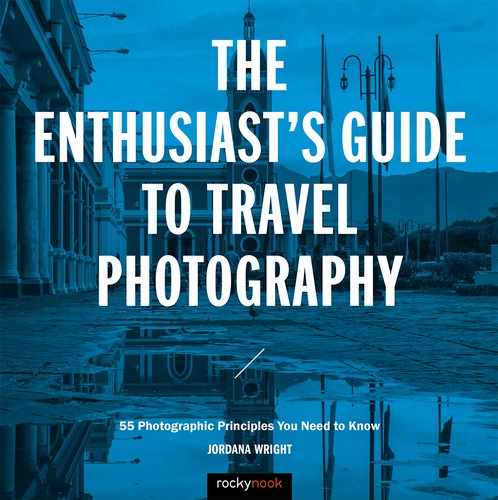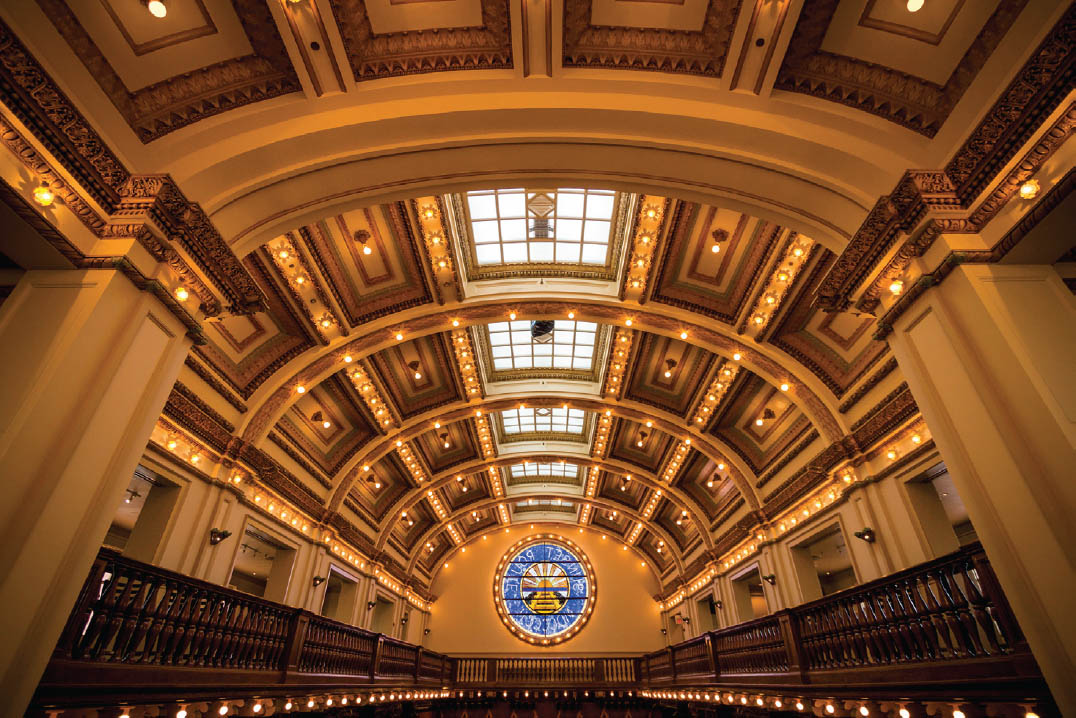49. SHOOTING PUBLIC INTERIORS

NO VISIT TO a world-class city is complete without exploring its famous museums, cathedrals, and other iconic structures. As fabulous as the exteriors are, interiors are often the lesser seen, lesser photographed, photogenic jackpots. New York has the Guggenheim. Chicago has Marshall Fields (Figure 49.1). The Vatican has the Sistine Chapel. If you’re a photographer, it’s impossible to visit these places without getting a few shots inside.
Sadly and irritatingly, in this era of heightened security and paranoia, photographers often get hassled in lots of public spaces. Taking photos in train stations, building lobbies, and museums can lead to confrontations with overzealous security guards. Over the years I’ve been approached lots of times and asked why I’m taking photos, or to stop altogether, even when there are no posted rules against photography. It drives me crazy. I’m all for keeping sensitive information safe and for protecting priceless art, but as I explained in lesson 4, “Cultural, Ethical, and Legal Considerations,” photographers have rights. We should do everything we can to protect them and lay the groundwork to get our ideal shots.
49.1 Marshall Fields, Chicago, Illinois
ISO 400; 1/60 sec.; f/3.5; 10mm
I’s Dotted, T’s Crossed
Before I visit an interior I know I’ll want to photograph, I check the location’s website for photography rules. If I have enough time before my visit and no rules are posted, I’ll send an email or fill out the contact form to find out exactly what the photography situation is. Very often, especially in lesser visited locations, just asking rather than assuming will lead to gaining permission. Many times the rules come with conditions like: No Flash Photography (which is easy to follow), or No Commercial Photography (which is more complicated depending on your definition of “commercial”).
If I happen upon a location I want to photograph along my journey and haven’t been able to research it ahead of time, I go right up to someone at the front desk or talk to a security guard. With a friendly smile I ask, “Is it all right if I take a few pictures in here?” or something along those lines. In many tourist locations, it’s pretty obvious if photography is okay, because dozens of other photographers will already have their cameras out and shooting. If I find myself in a quiet chapel or another smaller location, I always talk to a security guard, compliment the space, and ask if photos are okay. Making compliments is critical—usually appreciation helps get permission.
If there is a location that I’m desperate to photograph and it’s typically not open to the public for photography, I email the location’s manager with an explanation of the kind of photographs I want to take, samples of my previous work, and an offer to share the resulting photographs with them (Figures 49.2 and 49.3). If I get permission, I always bring a printed copy of any related emails when I visit to help with any confusion, mis-communication, or scheduling hiccups.
During the research phase of my America by Rail project, I was given permission by Amtrak to photograph in all of the train stations on their route. I printed the permission letter, carried it with me, and was actually asked to present it a few times over the course of the trip. The more you can set up in advance, the better.
49.2 San Antonio Station, San Antonio, Texas
ISO 200; 1/60 sec.; f/4; 10mm
49.3 Union Station, Los Angeles, California
ISO 165; 1/10 sec.; f/4.5; 10mm
Dealing with Limitations
Inevitably the interiors you’re dying to shoot will have a hefty list of rules. In museums the rules might even vary from exhibit to exhibit or artwork to artwork. Typically museums are less concerned with whether you’re shooting the physical structures and architecture than the art itself, but you can expect most museums to forbid flash and tripods—both for good reason. Flash can damage the art over time and tripods are a hazard and a nuisance in heavily visited areas.
Unfortunately, museums also tend to be shadowy, with all the art brilliantly lit. If I want to photograph in a darkish location without a tripod and boosting my ISO isn’t going to cut it, I either rely on a low profile tripod like my Platypod Max placed on the floor or a railing (Figure 49.4) or I sit on a bench and shoot from my lap for support. If all else fails, I lock my elbows to my torso and shoot like a sniper (breathe in, hold the breath, photograph for two to three seconds, and then breathe out). Regardless of how I shoot in museums, I make sure not to linger for too long in any one spot or impede the flow of foot traffic.
In houses of worship, the primary limitation is usually disruptive sounds and movement, and being respectful to those who are there to pray. Generally, it’s a good idea to avoid visiting during services, but even during slower times of day, I turn off my camera’s beeps, pay careful attention to what’s going on around me, shoot selectively (the sound of shooting on burst echoes like crazy in a church), and walk like a ninja. I usually try to stick to side aisles because they’re often less distracting to worshipers, and I avoid going up on the pulpit or bema unless I’m invited.
Shots to Consider
Some architectural interiors are going to be an absolute no-brainer for you. Vaulted or mosaic ceilings (Figures 49.5 and 49.6), sweeping open atriums (Figure 49.7), repetition of columns or windows, or intricate details may all call out to you as obvious compositions. In museums, you may feel inspired to photograph the art, but it’s unlikely you’ll end up using those images (you may not be allowed to anyway). Frame your shots to share your experiences rather than the specific artifacts. Consider instead photographing full rooms or halls (Figure 49.8), the way the light plays on sculptures, or reflections in shiny marble floors.
Other museum-goers can be worth photographing, but be careful how you handle yourself. Don’t get in anyone’s way of enjoying the art, and keep your portrait subjects unidentifiable if possible. Photographers, as artists, should do everything they can to help support the efforts of museums and to perpetuate the appreciation of art. If you do feel that you absolutely must have a photo of a certain piece of art, consider buying a postcard or a print in the gift shop to help support the museum.
49.4 The Orpheum Theatre during a changeover, Memphis, Tennessee
ISO 100; 6 sec.; f/5.6; 10mm
49.5 Temple Emanu-El, New York, New York
ISO 100; 2 sec.; f/6.3; 10mm
49.6 Almudena Cathedral, Madrid, Spain
ISO 640; 1/40 sec.; f/4; 17mm
49.7 Adolfo Suárez Madrid–Barajas Airport, Madrid, Spain
ISO 100; 1/25 sec.; f/5.6; 20mm
49.8 National Portrait Gallery, Washington, D.C.
ISO 100; 1/6 sec.; f/5.6; 20mm








